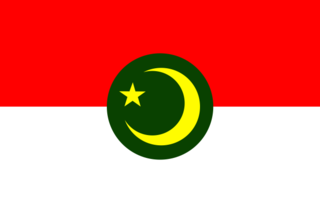
Narathiwat is one of the southern provinces (changwat) of Thailand. Neighbouring provinces are Yala and Pattani. To the south it borders the Malaysian states of Kelantan and Perak. The southern railway line ends in this province, which is one of the nation's four provinces that border Malaysia. The province features a range of cultures as well as natural resources, and is relatively fertile. Narathiwat is about 1,140 kilometers south of Bangkok and has an area of 4,475 km2 (1,728 sq mi). Seventy-five percent of the area is jungle and mountains and has a tropical climate.

The Southern Thailand Insurgency is an ongoing conflict centered in southern Thailand. It originated in 1948 as an ethnic and religious separatist insurgency in the historical Malay Patani Region, made up of the three southernmost provinces of Thailand and parts of a fourth, but has become more complex and increasingly violent since the early 2000s from drug cartels, oil smuggling networks, and sometimes pirate raids.
The 2005 Songkhla bombings were a series of three bombings that took place on 3 April 2005 in the cities of Hat Yai and Songkhla of Thailand's Songkhla Province. They are believed to be part of the ongoing South Thailand insurgency. At least two people were killed and 66 were injured in the explosions.

The Barisan Revolusi Nasional Melayu Patani, also known by the shorter form Barisan Revolusi Nasional ), meaning "National Revolutionary Front", is an Islamist Patani independence movement in northern Malaysia and Patani, southern Thailand. As of 2017, it is the most powerful rebel group in the region.
Incidents of terrorism in Thailand are mostly related to the South Thailand insurgency, which has been going on for decades. Sporadic incidents have also occurred elsewhere, although such events are much less common.
The 2007 South Thailand bombings were a series of bombings that hit Narathiwat, Pattani, Songkhla and Yala during the Chinese New Year celebrations on 18 and 19 February. At least seven people were killed. The bombings were the first time the rebels had simultaneously struck all four southern provinces. The attacks on Sunday and early Monday targeted mostly residential and business establishments owned by Buddhists or ethnic Chinese.
The June 2011 Peshawar bombings occurred on 12 June 2011 in Peshawar, Khyber Pakhtunkhwa, Pakistan. At least 34 people were killed, and more than 90 were injured, when two bombs exploded in a market around midnight. Three people were hurt when the first bomb exploded at 11:50 p.m. local time in the commercial and residential area of Khyber market. After a crowd gathered in the area, a teen-aged suicide bomber on a motorcycle set off a second explosion, killing many people on the spot. About 10 kilograms (22 lb) of explosives were used in the second blast according to officials. Police and rescue teams soon reached the spot and cordoned the area.

The 2012 Southern Thailand bombings were a series of bombings that took place in Yala, Yala Province and in Hat Yai, Songkhla Province, on 31 March 2012.

Hat Yai Junction is an international railway junction and a Class 1 railway station for the State Railway of Thailand in the center of Hat Yai City, Songkhla Province, Thailand. The station is located 928.585 km (577.0 mi) from Bangkok's Thon Buri railway station and serves as a junction for the mainline Southern Line towards Pattani, Yala and Sungai Kolok and Padang Besar, Kuala Lumpur and Singapore Line. The station yard is the location of a large locomotive depot: Hat Yai Depot, the southernmost railway depot in Thailand.
The year 2013 was the 232nd year of the Rattanakosin Kingdom of Thailand. It was the 68th year in the reign of King Bhumibol Adulyadej, and is reckoned as year 2556 in the Buddhist Era. The year saw the beginning of protests against Prime Minister Yingluck Shinawatra's government which led to a state of political crisis and the dissolution of government.
The Runda Kumpulan Kecil is a jihadism insurgent group operating in three southern border provinces of Thailand and some areas of Songkhla province.
This article lists a chronology of events in the South Thailand insurgency from the 1960s. Most take place in the Muslim-majority, contested provinces of Narathiwat, Pattani, and Yala in the far south of Thailand bordering Muslim Malaysia.
Tanyong Mat railway station is a railway station located in Tanyong Mat Subdistrict, Ra-ngae District, Narathiwat, Thailand. The station is a class 1 railway station located 1099.503 km from Thon Buri railway station. Tanyong Mat opened in March 1920, as part of the Southern Line Balo-Tanyong Mat section.
Chana station is a railway station located in Ban Na Subdistrict, Chana District, Songkhla. It is a class 1 railway station located 964.503 km (599.3 mi) from Thon Buri railway station.
Raman railway station is a railway station located in Kayu Boko Subdistrict, Raman District, Yala, Thailand. It is a class 1 railway station located 1,056.824 km (656.7 mi) from Thon Buri railway station.
Rueso railway station is a railway station located in Rueso Subdistrict, Rueso District, Narathiwat. It is a class 1 railway station located 1,071.191 km (665.6 mi) from Thon Buri railway station.
Cho-airong station is a railway station located in Chuap Subdistrict, Cho-airong District, Narathiwat. It is a class 2 railway station located 1,111.15 km (690.4 mi) from Thon Buri railway station.
Bukit station is a railway station located in Bukit Subdistrict, Cho-airong District, Narathiwat. It is a class 3 railway station located 1,115.83 km (693.3 mi) from Thon Buri railway station.
The year 2019 is the 238th year of the Rattanakosin Kingdom of Thailand. It is the fourth year in the reign of King Vajiralongkorn, and is reckoned as year 2562 in the Buddhist Era.





